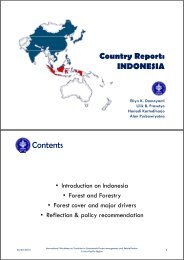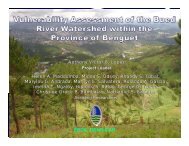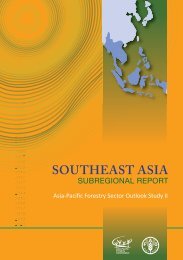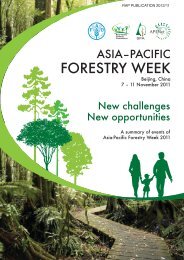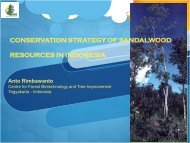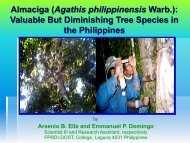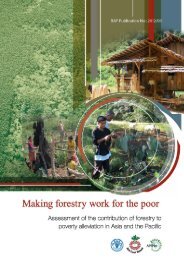Community guidelines for accessing forestry voluntary carbon ... - FAO
Community guidelines for accessing forestry voluntary carbon ... - FAO
Community guidelines for accessing forestry voluntary carbon ... - FAO
You also want an ePaper? Increase the reach of your titles
YUMPU automatically turns print PDFs into web optimized ePapers that Google loves.
<strong>Community</strong> <strong>guidelines</strong> <strong>for</strong> <strong>accessing</strong> <strong>for</strong>estry <strong>voluntary</strong> <strong>carbon</strong> markets<br />
Regarding the PD/PDD:<br />
The validation of a methodology is a paper exercise but the validation<br />
of a PD/PDD typically involves an on-site visit by an audit team. This is<br />
necessary to check the assumptions and parameter values that the PD/<br />
PDD uses to quantify the <strong>carbon</strong> benefits of the project. The audit team<br />
must also review the potential environmental impacts and stakeholder<br />
comments. This cannot be done from behind a desk. The cost of an audit<br />
is quite variable but is usually at least USD 25 000.<br />
Once the PD/PDD receives a favourable validation report, the project<br />
is officially approved and can then be registered. The list of approved<br />
projects can be found on the websites of each standard body. Only after<br />
a project is registered can it begin to generate <strong>carbon</strong> credits. Validation<br />
of PDs and PDDs is conducted by a Validation/Verification Body (VVB).<br />
In the case of the VCS, the validation of the PD can be combined with<br />
verification of <strong>carbon</strong> sequestration (see Chapter 5).<br />
When inviting a VVB to validate the PD, the following issues must be<br />
kept in mind:<br />
a) In<strong>for</strong>mation on stakeholder consultations must be compiled<br />
and incorporated into the PD. The PD must also clearly indicate<br />
how the concerns raised during this consultation have been<br />
(or will be) addressed.<br />
b) The auditors from the VVB will review all relevant documents<br />
and visit the project site. They will issue Corrective Action<br />
Requests (CARs) or New In<strong>for</strong>mation Requests (NIRs) to reflect<br />
any deficiencies or inaccuracies in the PD.<br />
c) Following the auditors’ report, it is very likely that a significant<br />
number of changes to the PD will be necessary. The project<br />
developer must address all of the CARs and NIRs and submit<br />
again to the VVB.<br />
112




